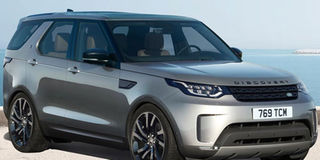The all new Land Rover Discovery

The Land Rover Discovery is obviously not a new car seeing that high profile people such as Kampala Lord Mayor, Erias Lukwago cruises one on the streets of Kampala.
The most popular in Uganda is the fourth generation Discovery that first went on the market in 2009.
The car has won more than 62 awards for its elegancy and offers exuded comfort and power that is only known among high end SUVs.
Away from the fourth generation Discovery, early this week Jaguar Land Rover South Africa announced it had outed a completely new design, which has similarities to Range Rover Sport.
According to Nicola Clarke, the Jaguar Land Rover South Africa public relations manager, the all-new Land Rover Discovery started hitting showrooms across sub-Sahara Africa in July.
The car has already been launched with journalists given an opportunity to have a feel driving around in South Africa’s scenic Limpopo Province.
Journalists tested its pace on the open and dirt roads.
Land Rover is a car brand that specialises in four-wheel-drive vehicles, owned by British carmaker Jaguar Land Rover, which has been owned by India’s Tata Motors since 2008. It is regarded as a British icon, and was granted a Royal Warrant by King George VI in 1951.
The Land Rover name was originally used by the Rover Company for the Land Rover Series, launched in 1948.
It developed into a brand encompassing a range of four-wheel-drive models, including the Defender, Discovery, Freelander, Range Rover, Range Rover Sport, and Range Rover Evoque.
The Land Rover Discovery is a mid-size luxury SUV that was first introduced in 1989 with the second series updated in 1998. The third generation was launched in 2004, before outing the Discovery fourth generation in 2009.
The fifth generation Discovery, which was built on a platform shared with the Range Rover and Range Rover Sport, omits the numeric suffix of the previous two versions.
It omits out many of the design traditions of former generations for a more modern, though less overtly practical car.
It also marks the return of the Discovery Marque in the US market, replacing the LR moniker of the previous generation models.
Features
The new Discovery incorporates several changes combining Land Rover’s aluminum architecture, which was first introduced on the Range Rover (L405).
The use of aluminum chassis and body panels gives a weight loss of up to 480 kilogramme, which has been combined with a new aerodynamic design, achieving fuel efficiency over previous generations.
It comes with a combination of V6 petrol and diesel engines and is equipped with a standard 8 speed automatic transmission.
It has a package of two speed transfer case (low range gearbox) and the option of an actively locking rear differential. Coil springs are now standard on base trim models, while air suspension is still offered as an option.
Land Rover has also introduced a Terrain Response 2 on the Discovery fifth generation that constantly monitors wheel slip, wheel speed, angle of approach or departure, and the suspension’s compression or rebound to adjust the anti-lock braking system, throttle response, differentials and traction control systems.
Driving experience
The driver has a number of options choosing different variances for snow, grass, gravel, mud ruts, sand and rock crawling.
The Terrain Response 2 also introduces a new ‘auto’ mode that allows the vehicles to select the most appropriate mode on its own.
The Discovery fifth generation is built on a unibody chassis, which allows the car to have higher torsional rigidity with less weight.
The latest generation has a higher wading depth (up to 35.6), improved ground clearance and a more comfortable ride.



